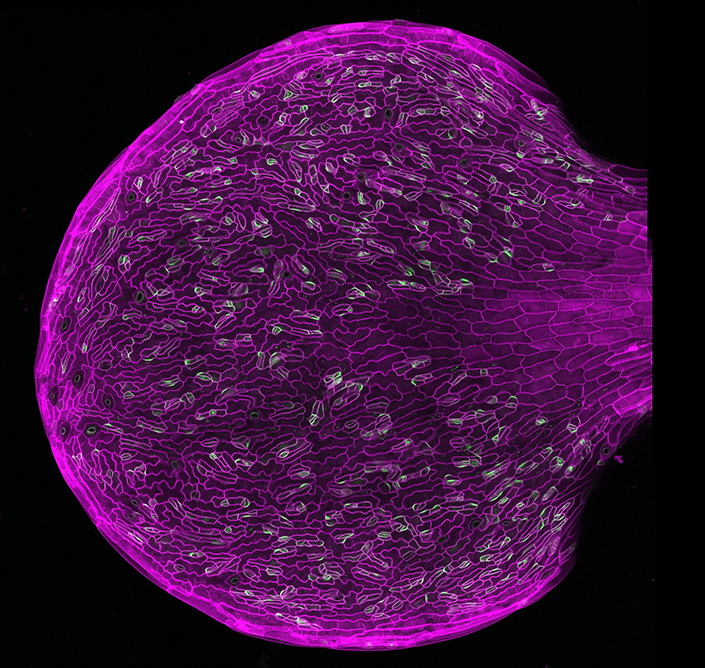2023-07-06 カリフォルニア大学サンディエゴ校(UCSD)

An image of a developing leaf from a mutant Arabidopsis plant (trm678). Mutants were used by researchers to determine how polarity (green) affects plant stem cells (outlined in magenta). Credit: Yan Gong
◆彼らは植物の細胞が「最短壁ルール」に従って分裂しないケースを観察し、分子レベルでそのメカニズムを解明しました。この発見は、将来的には植物の創造性や形態を変えるための応用技術や気候変動への対応を支援する可能性があります。
◆研究者たちは、植物の発達や繁栄における細胞の特殊な情報伝達の複雑な組み合わせを理解することを目指しており、今後はこのメカニズムの役割やその力を利用する方法を研究する予定です。
<関連情報>
- https://today.ucsd.edu/story/new-insight-into-how-plant-cells-divide
- https://www.science.org/doi/10.1126/science.add6162
皮質の極性は、葉の表面をパターン化するために、気孔の系統において非対称的な遺伝を行う。 Cortical polarity ensures its own asymmetric inheritance in the stomatal lineage to pattern the leaf surface
Andrew Muroyama,Yan Gong,Kensington S. Hartman,and Dominique C. Bergmann
Science Published:6 Jul 2023
DOI:https://doi.org/10.1126/science.add6162
Editor’s summary
Many tissue-patterning processes involve asymmetric cell divisions that determine subsequent cell fate. Working with the Arabidopsis guard cell lineage, Muroyama et al. found that the polarly localized proteins BASL/BRXf generate a region where cell division planes cannot occur (see the Perspective by Goldy and Caillaud). BASL/BRXf locally suppressed formation of the preprophase band, which then formed elsewhere to appropriately place the cell division site. When the preprophase band was disrupted, neither guard cells nor epidermal pavement cells formed. Within the polarity domain, organizational dynamics of microtubule plus-ends were disrupted, depleting microtubules from the zone. This study uncovers a mechanism for plant tissue patterning that ensures the inheritance of cell fate determinants to a single daughter cell. —MRS
Abstract
Asymmetric cell divisions specify differential cell fates across kingdoms. In metazoans, preferential inheritance of fate determinants into one daughter cell frequently depends on polarity-cytoskeleton interactions. Despite the prevalence of asymmetric divisions throughout plant development, evidence for analogous mechanisms that segregate fate determinants remains elusive. Here, we describe a mechanism in the Arabidopsis leaf epidermis that ensures unequal inheritance of a fate-enforcing polarity domain. By defining a cortical region depleted of stable microtubules, the polarity domain limits possible division orientations. Accordingly, uncoupling the polarity domain from microtubule organization during mitosis leads to aberrant division planes and accompanying cell identity defects. Our data highlight how a common biological module, coupling polarity to fate segregation through the cytoskeleton, can be reconfigured to accommodate unique features of plant development.


